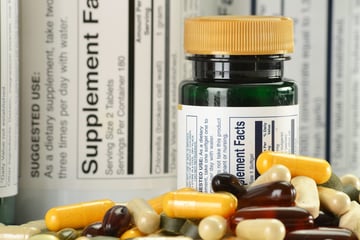In the United States, the Food and Drug Administration (FDA) has identified 9 foods that qualify as major allergens and created legislations to determine how they should be declared on labels for consumer awareness. Two laws – the Food Allergen Labeling and Consumer Protection Act (FALCPA) of 2004 and the Food Allergy Safety, Treatment, Education and Research (FASTER) Act of 2021 – established the nine allergens that food manufacturers must declare: milk, eggs, fish, shellfish, tree nuts, peanuts, wheat, soybeans, and sesame (which was the most recent addition as of January 1, 2023).
Improperly labeled foods and undeclared allergens are a leading cause of a food recalls, which can be a costly mistake for food businesses. However, allergen labeling can get complicated when your food is made in a shared facility with other foods that contain allergens.
Cross-contact occurs when food allergens are unintentionally transferred into other foods during the processing, preparation, or manufacturing process. For consumers with a high allergen sensitivity, cross-contact can be extremely harmful. However, for food manufacturers, it can happen rather easily if you don’t have the right processes in place. Let’s break down some of the best ways to communicate allergens to customers and reduce cross-contact along your supply chain.
A Note on Precautionary Allergen Labeling
The FDA offers clear guidance on labeling allergens in foods, but what about precautionary statements? Voluntary allergen statements, also referred to as precautionary allergen labeling, use the wording “may contain (allergen)” or “produced in a facility with (allergen)” under the list of ingredients on a food label. This may seem like an easy solution for notifying consumers of potential cross-contact. However, the FDA wants to be clear to businesses: voluntary statements should not be used in replacement of implementing good manufacturing practices.
Dr. Stefano Luccioli, an allergen specialist, shared in an FDA Q&A:
“Manufacturers cannot just place an advisory statement on a product without first taking measures to prevent allergen cross-contact to the best degree possible. Under the Current Good Manufacturing Practice, Hazard Analysis, and Risk-Based Preventive Controls for Human Food (CGMP & PC) rule, major food allergens are regarded as food hazards, and manufacturers are required to implement procedures, practices, and processes when necessary to significantly minimize or prevent allergen cross-contact of major food allergens.”
As the FDA conducts audits and investigations, they will continue to assess cross-contact challenges and offer guidance to businesses based on industry best practices. So, let’s dive into some of those best practices.
1. Conduct a Thorough Review of Ingredients to Ensure Accurate Labeling
A key component of allergen regulation revolves around your product’s ingredients and labels, so there’s no better place to start than with a thorough review. Inspect your supplier ingredient lists and compare them to your product labels to ensure any allergens listed are properly declared. If anything is unclear, contact your suppliers for clarification.
However, keep in mind that allergens can sometimes be hidden in ingredients lists. Sesame, the most recent allergen to be added to the list, is commonly used in spice mixes, seasoning, and international cuisine. As a result, it has many names, including tahini, ellu, geching, benne or benniseed, and others. Be aware of the potential synonyms of allergens and ensure that your labels accurately declare the allergens using their common names.
As an example, sesame might be listed in your ingredient list as “spice mix (sesame)” and declared as an allergen with "Contains: Sesame”.
2. Maintain Accurate Records
There are a couple reasons why you should keep records of your ingredients, processes, and manufactured foods. Beginning soon, businesses will be expected to keep traceability records of foods (and ingredients) that are included on the FDA’s Food Traceability List (FTL). The FTL is part of the FDA’s final rule on the Food Safety Modernization Act (FSMA) Section 204, which has a compliance deadline of January 20, 2026. Many of the foods on the FTL are major allergens, as the FDA is trying to improve traceability and recall management of potential food hazards (both allergens and foodborne illnesses).
By keeping records, you’ll not only maintain compliance with FSMA 204 when it arrives, but you’ll also be more prepared in the event of an FDA audit or investigation. Your records may include (but not be limited to):
- Traceability Lot Codes (TLC), Critical Tracking Events (CTE), and Key Data Elements (KDE); all part of FSMA 204 compliance for foods on the FTL.
- Copies of labels and ingredient lists for products, as well as where the ingredients were sourced (supplier information).
- A detailed list of procedure for your traceability plan (required for FSMA 204), food safety audit plan, food recall plan, and Hazard Analysis and Critical Control Point (HACCP) plan.
- Copies of allergen testing, sample tests, and other relevant evaluations.
3. Implement Allergen Management Protocols
In the FDA’s CGMP & PC rule (21 CFR part 117, Subpart B), they outline current Good Manufacturing Practices (GMP) and sanitation standard operating procedures (SSOPs) that companies should implement to control disease, minimize risk, and reduce the chance of allergen cross-contact. Subpart B covers everything from food storage and washing, to employee cleanliness and other measures. Here are some of the ways manufacturers can reduce the chances of cross-contact:
- Keep allergens separate from non-allergens in facilities, and use different storage containers, lines, and other equipment for allergen foods (if possible).
- Schedule allergen foods to be the last on the production line before the lines are cleaned and closed for the night/shift.
- If allergens need to be cold stored near non-allergen foods, store them below non allergens so potential condensation or broken packaging doesn’t contaminate non-allergen foods.
- Establish thorough cleaning regimens for lines after running allergen foods.
Be sure to communicate your expectations and protocols with both your employees and suppliers. While your facility may have strict rules, your suppliers may not, so it’s important to communicate expectations to avoid cross-contact.
4. Train Employees on Allergen Awareness
Once you’ve established an allergen management program and other measures to prevent allergen cross-contact, you’ll need to train employees on all these procedures. In a notice to fish and fishery establishments, the FDA noted that allergen training should include these three concepts, at minimum:
- Identify the nine major allergens and the hazards they pose to sensitive individuals.
- Cover the principles of allergen cross-contact prevention, such as why it matters and how even low thresholds of allergens can be detrimental to consumers and cause a recall.
- Cover your allergen processes, prevention controls, and protocols, as well as any corrective actions and required recordkeeping that your team will need to maintain.
5. Conduct Allergen Testing and Aim for Continuous Improvement
Manufacturers should perform regular testing of their food products and productions lines to ensure allergen cross-contact doesn’t occur. If the FDA performs an audit or inspection, they will run tests as well, so it’s best to do regular testing so you can stay ahead of a potential fine or recall. Additionally, the FDA has not currently set a threshold for allergens, so any amount of allergen in a food will require the proper labels and declarations.
As you continue to test and analyze your processes, aim for continuous improvement. When mistakes happen, have steps in place to adjust the error or remind employees of the allergen protocols in place. And be willing to make changes, either based on FDA guidance, industry news, or lessons from trial-and-error.
Bonus: Harness Technology to Aid in Compliance
While tracking allergens and potential hazards along the supply chain can be done with old-school spreadsheets and paper, there are much easier ways to maintain records and minimize risks.
Food manufacturers can rely on labeling and formulation solutions that use built-in government guardrails to automate allergen declarations or precautionary statements. Plus, you can meet FSMA 204 enhanced traceability recordkeeping requirements and reduce risks related to recalls with end-to-end traceability, supplier management, and recall management tools. Curious to learn more? Contact our team to schedule a demo today.
Other posts you might be interested in
View All Posts
Food Labeling
12 min read
| March 15, 2023
How to Accurately Label Allergens On Dietary Supplement Facts Panels
Read More
Product Formulation
12 min read
| January 27, 2023
Understanding Food Allergen Regulations in 2023
Read More
Product Formulation
12 min read
| June 21, 2023

